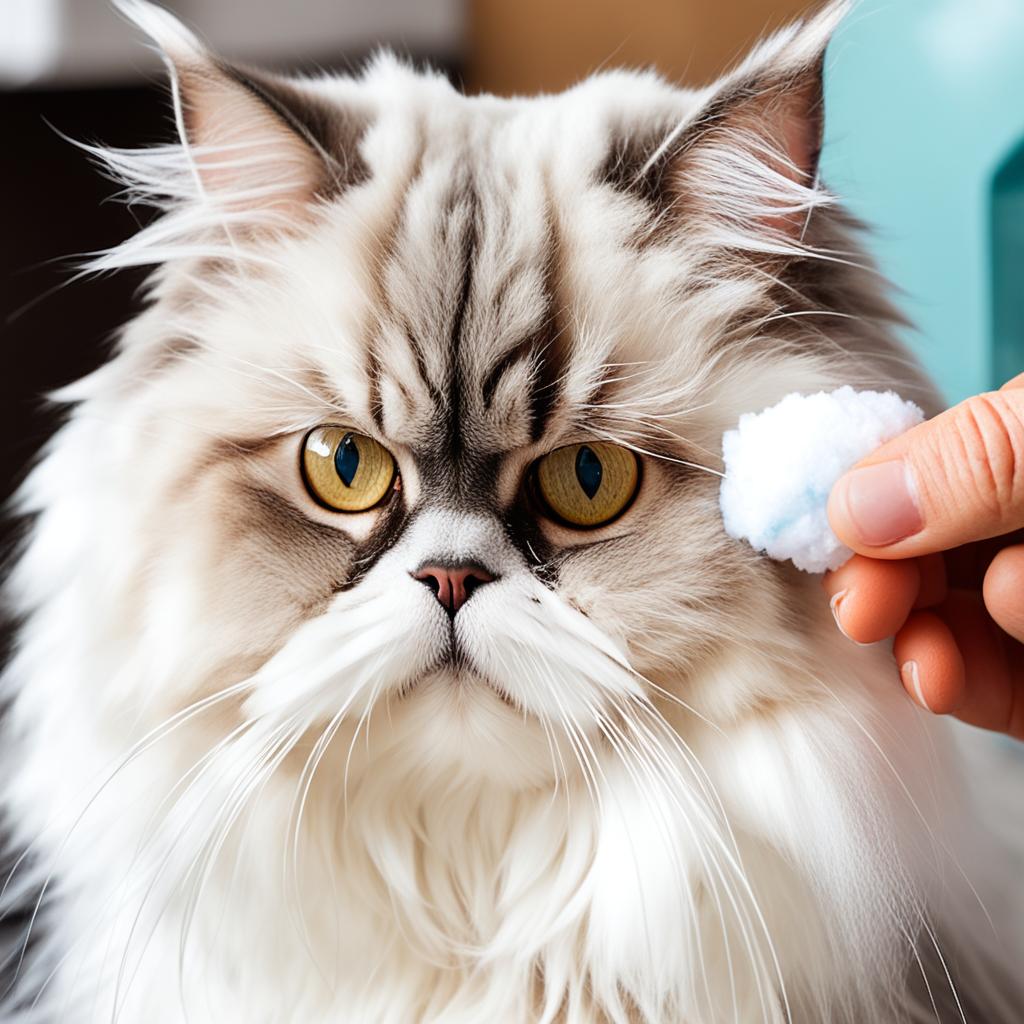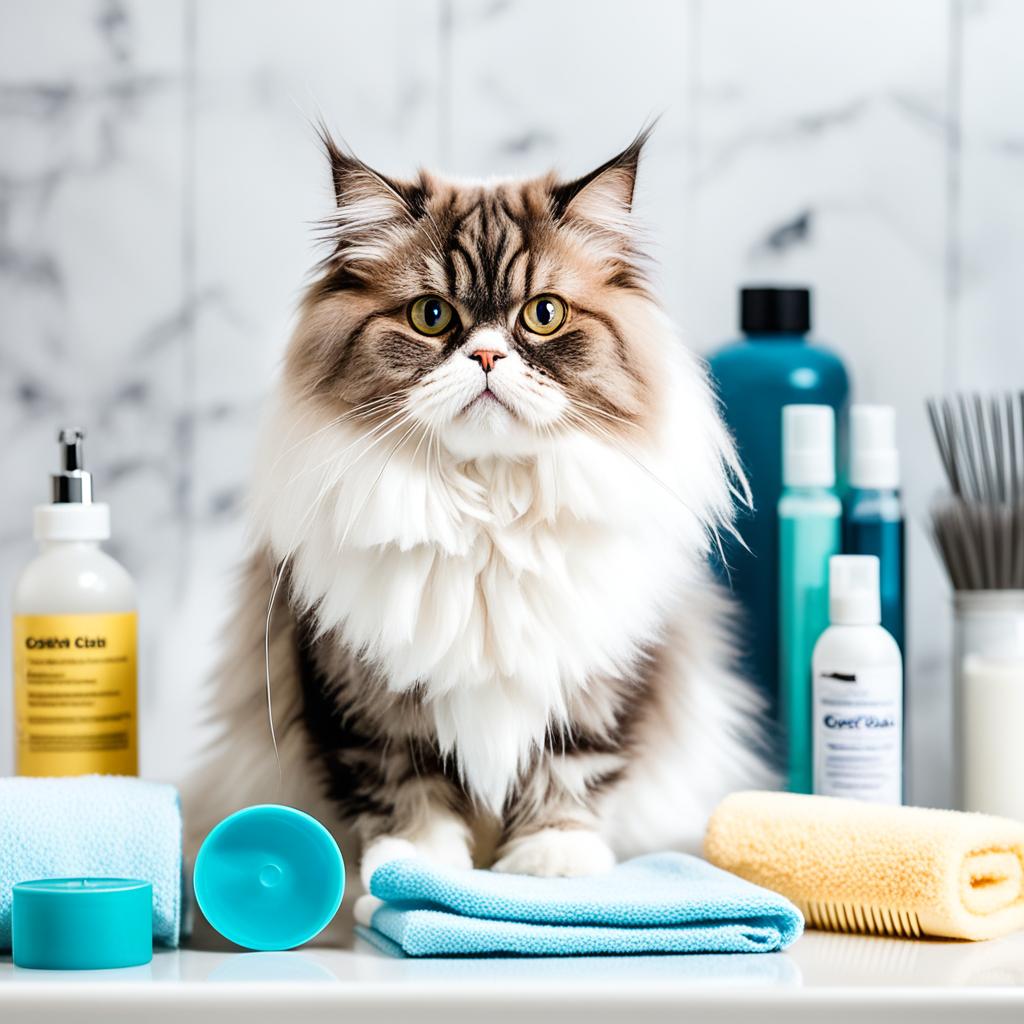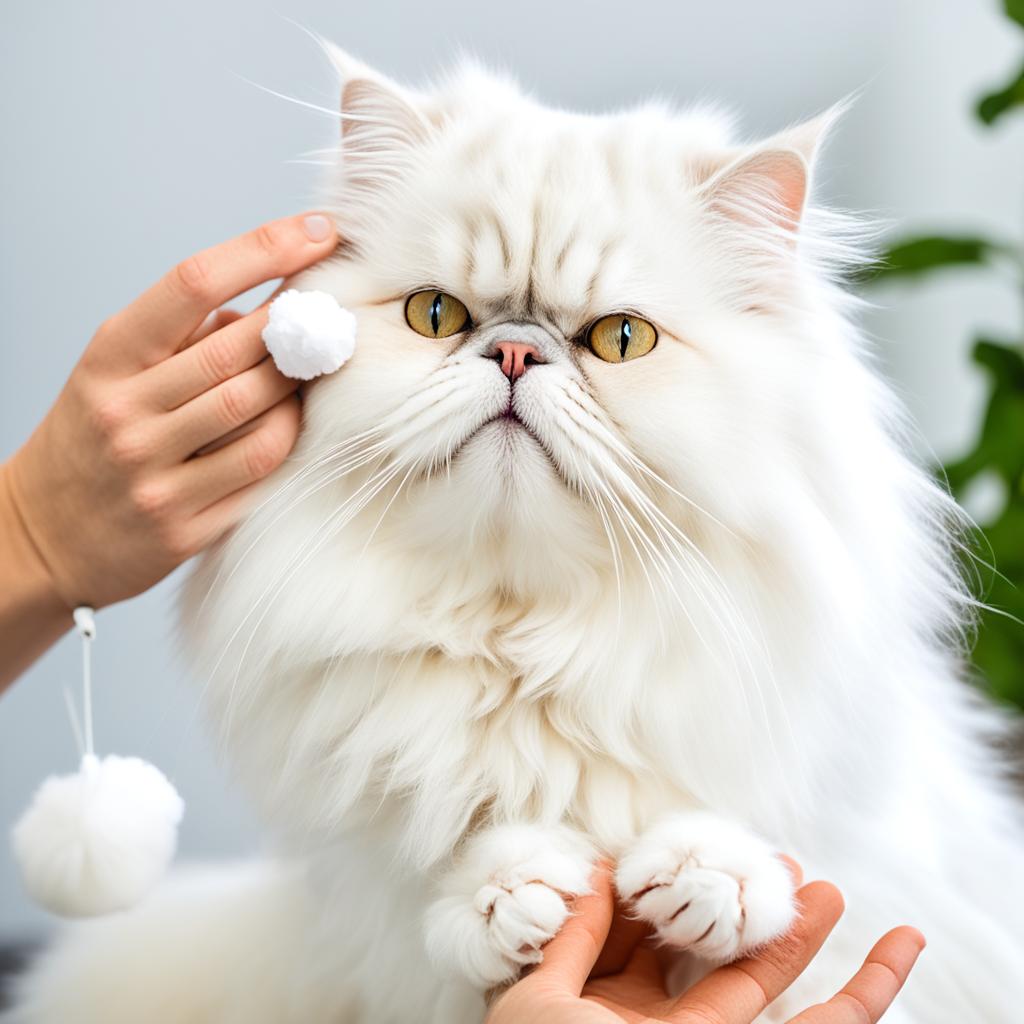Nearly 90% of Persian cat ear infections come from bad ear care. This fact shows why it’s key to keep a Persian cat’s ears clean. Their ears are special and prone to having more wax. So, cleaning them often is very important. If you don’t, your cat might feel a lot of pain or get infections.
When cleaning a Persian cat’s ears, choose a cleaner the vet recommends. Stay away from products with hydrogen peroxide or alcohol. They might make things worse, especially if the ear is already sore. You’ll need a good ear cleaning solution and something to catch the dirt, like cotton balls. Always avoid using Q-tips® to stop any harm or pushing wax deeper.
Some cats don’t need their ears cleaned a lot. But if your Persian cat’s ears look dirty or smell bad, it’s time to clean them. Your vet can show you the right way to do it if your cat seems uncomfortable. Getting professional advice is smart if your cat’s ears look painful or cause trouble.
Key Takeaways
- Persian cats have special ear needs and should be cleaned often.
- Stick to a vet’s pick for ear cleaning to avoid harming the ears.
- Don’t use Q-tips® to keep your cat’s ears safe.
- Watch for warning signs like dirty ears or bad smells.
- Always get help from a vet if your cat seems in pain or upset.
Introduction to Persian Cat Ear Cleaning

Persian cats are beautiful and have special personalities but don’t need much grooming. Yet, learning how to clean Persian cat ears is crucial. If a cat doesn’t groom its ears well, problems can arise. It’s important to check their ears often to keep them healthy.
To keep a Persian cat’s ears clean, look for certain signs regularly. Watch for things like bad smell, redness, or if the cat seems sore. These could mean the cat has an ear infection. If you see these signs, it’s better to have a vet clean the ears.
If you clean the ears at home, it’s best to use a safe product like Epi-Otic. Put a little on a cotton ball for easy and safe use. Remember, never use cotton swabs. They might hurt the cat’s ear drum by pushing dirt too far in.
Learning Persian cat hygiene tips is about knowing when to see a vet. It’s also about safely cleaning ears at home. Always think of your cat’s comfort and health first. Watch them closely and use the right cleaning methods.
Understanding the Importance of Ear Hygiene

It’s key to keep ear care for Persian cats in check. They are more prone to ear problems. This is due to their small ear canals and thick fur. Checking and cleaning your Persian’s ears regularly stops any pain or big issues.
Why Regular Ear Cleaning is Essential
Regular cleanings help keep Persian cats’ ears healthy. It gets rid of dirt and wax that might cause infections or annoyances. Clean ears prevent problems like too much scratching or shaking heads.
Signs of Ear Problems in Persian Cats
If your cat’s ears show a wax buildup, smell bad, or they shake their head, it could be an issue. These signs might mean there are ear mites or yeast. Always ask a vet before treating this yourself.
Necessary Tools and Preparations

Getting ready to clean your Persian cat’s ears is key to good care. The first step is to gather the right tools. This prepares you for helping your cat’s ear health stay top-notch.
Items You’ll Need
To make sure ear cleaning goes well, get these tools ready:
- A vet-recommended ear cleaning solution
- Cotton balls or gauze
- Treats or rewards
Don’t use cotton-tipped applicators. They can hurt the sensitive ear areas. Keeping these Persian cat hygiene tips supplies prepared ensures your cat’s comfort and safety.
Choosing the Right Ear Cleaner
Picking the best ear cleaner is essential for your cat’s ear care. Choose one that your vet suggests. It should be made for Persian cats. Make sure it’s both gentle and does a good job. Using the wrong cleaner can irritate or hurt your cat.
| Item | Purpose |
|---|---|
| Vet-recommended ear cleaning solution | Cleanse and remove debris from the ears |
| Cotton balls or gauze | Wipe away loosened debris from the ears |
| Treats or rewards | Make the cleaning experience positive |
By choosing the correct products and sticking to grooming Persian cat’s ears advice, cleanings can be easy and safe. This way, your cat stays joyful and healthy.
How to Clean a Persian Cat’s Ears?

To clean your Persian cat’s ears, you must be gentle and calm. This ensures their comfort and safety. Here’s a simple guide to clean a Persian cat’s ears:
Step-by-Step Cleaning Guide
Start by calmly holding your cat. You can use a towel to keep them in your lap. Next, gently pull their ear flap back. This will help you reach the inside of the ear.
Use a vet-approved ear cleaning solution. Allow some to spill out to clean deeply. Gently massage the base of the ear to loosen any dirt.
Now, use a cotton ball or gauze to clean the ear. Let your cat shake its head. This removes any remaining dirt and solution. Don’t use cotton-tipped applicators. They can harm the ear. Do these steps for both ears. And don’t forget to reward your cat with treats for cooperating.
When to Consult a Veterinarian
If your cat seems in pain or resists during cleaning, stop. You should then consult a vet for advice. If your cat needs medication in their ears, do this after cleaning. Always follow your vet’s instructions. It’s also smart to check in with your vet regularly for proper ear care.
Tips for Maintaining Persian Cat Ear Health
Keeping your Persian cat’s ears healthy needs regular care and the right cleaning methods. Check their ears often to spot any issues early. This makes it easier to take care of your cat’s ears.
Brushing your cat every day is very helpful, especially behind their ears. Mats can form there, and brushing stops this. It also cuts down on dirt that could harm their ears. Use cleaning stuff that your vet recommends. Avoid things that could hurt their ears.
Good food and plenty of water are key for your cat’s entire body, including their ears. A healthy diet boosts their immune system. This helps keep their ears safe from infections. Dental treats can also help keep their ears healthy. Stick to these tips to keep your Persian cat’s ears in good shape.




